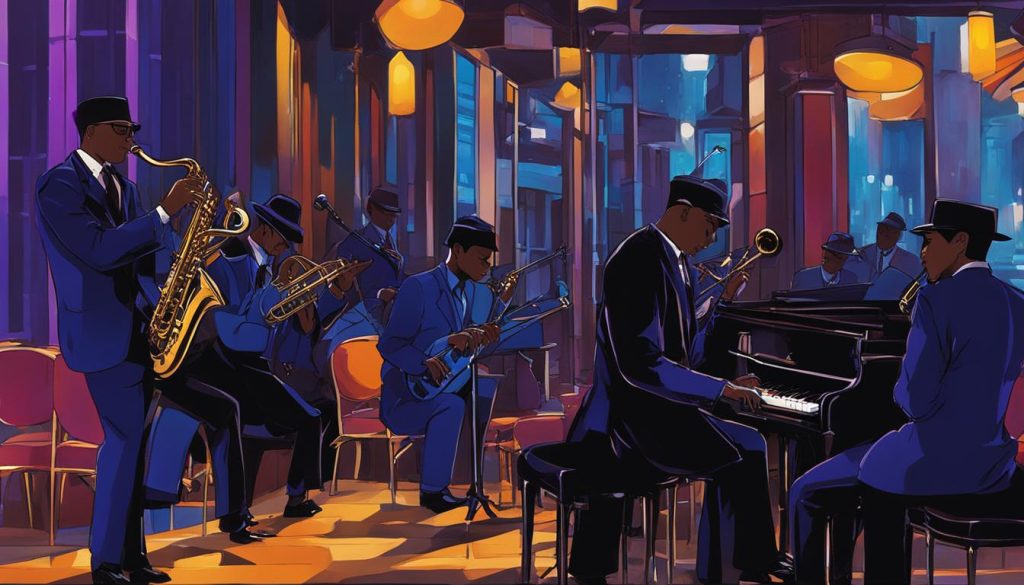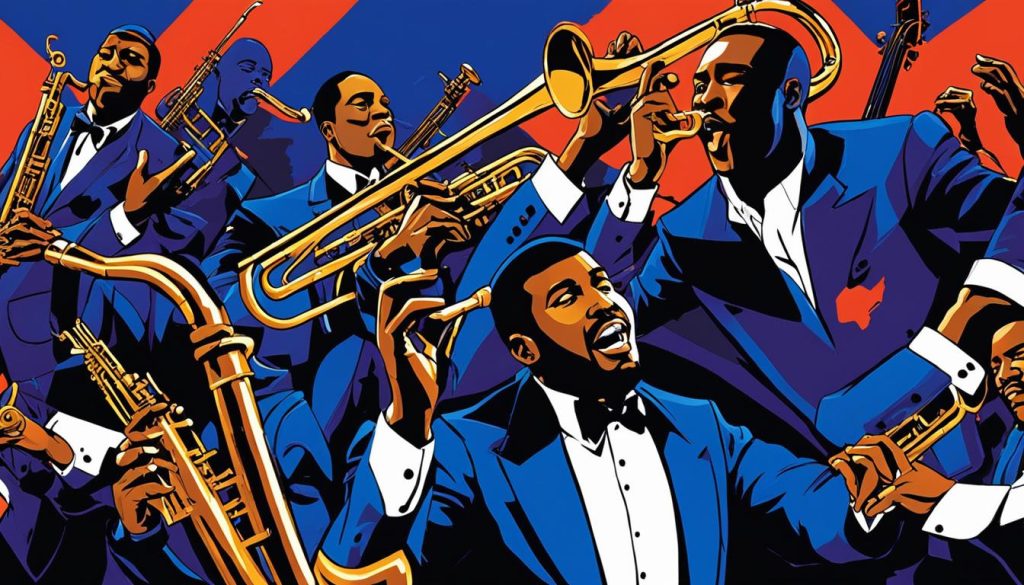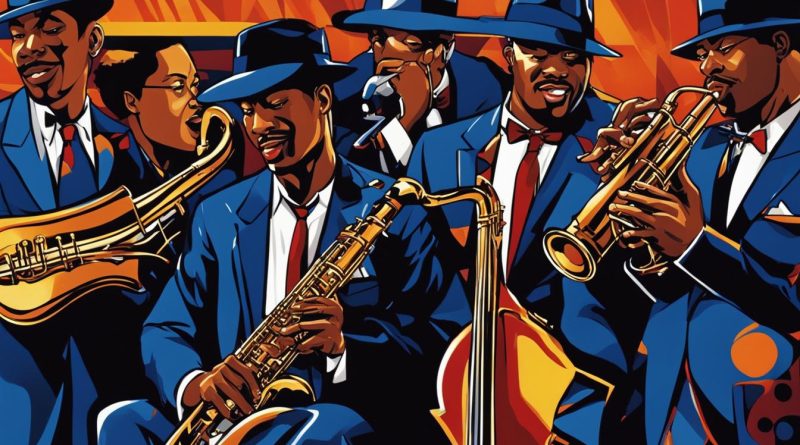Mo Better Blues: Jazz Influence & Cultural Impact
“Mo Better Blues” is a timeless film that has left an undeniable impact on both jazz music and popular culture. Its exploration of jazz roots and representation of the African-American experience has resonated with audiences for decades, solidifying its place in film and music history as a poignant and enduring work of art.
In this section, we will delve into the profound jazz influence and cultural impact of “Mo Better Blues.” Through this examination, we will uncover how this film has influenced and shaped the world of jazz as well as the broader cultural landscape.
Key Takeaways:
- “Mo Better Blues” explores the spirit of jazz music, its historical context, and significance in the movie.
- The film portrays the African-American experience and representation of jazz culture with great cultural resonance.
- “Mo Better Blues” has solidified its place in film and music history as a testament to the enduring power of jazz and its ability to transcend boundaries and touch the souls of audiences worldwide.
Exploring the Jazz Roots of Mo Better Blues
Mo Better Blues pays homage to the jazz genre, which has deep roots in African American culture and history. Spike Lee masterfully captured the essence of jazz and its cultural significance within the movie.
The film is set in the 1990s, but it takes us on a journey back to the early 20th century, where jazz blossomed in the city of New Orleans. The use of historical context allows the audience to appreciate the origins and evolution of jazz music. The performances by jazz legends such as Branford Marsalis and Terence Blanchard are a testament to the authenticity of the movie’s depiction of the jazz culture.

The music in the film is not just an accompaniment to the story but a character itself. Lee’s portrayal of jazz serves as a metaphor for the complexities of human relationships and the creative process. The nuanced interpretation of jazz by the movie’s characters adds depth to the storyline.
“We talkin’ ’bout a different thing here. We talkin’ ’bout jazz, man.” – Bleek Gilliam (Denzel Washington)
The Jazz Performances Within Mo Better Blues
The role of jazz music is underscored throughout the movie. The jazz performances are beautifully choreographed, using a combination of close-ups and wide-angle shots to create a sense of intimacy and grandeur. The music is emotional, carrying the audience along with the story’s highs and lows.
| Jazz Musicians | Instrument |
|---|---|
| Bleek Gilliam (Denzel Washington) | Trumpet |
| Shadow Henderson (Wesley Snipes) | Saxophone |
| Left Hand Lacey (Samuel L. Jackson) | Piano |
The musical performance scenes evoke the feeling of a live jazz concert, transporting the viewers into the smoky jazz clubs of New York. The scenes also showcase the technical skill and improvisational nature of jazz musicians.
Overall, Mo Better Blues’s jazz roots run deep, making it an essential film for music and jazz enthusiasts.
The Cultural Resonance of Mo Better Blues
Mo Better Blues is a film that not only celebrates the jazz music scene but also delves into the African-American experience. Through its compelling portrayal of the complexities of jazz culture, the film has resonated with audiences worldwide and sparked discussions about issues of race, identity, and representation.
At the heart of Mo Better Blues is the story of Bleek Gilliam, a talented jazz musician, and his struggles to balance his passion for music with various personal challenges. Spike Lee’s masterful direction, coupled with the performances of actors like Denzel Washington and Wesley Snipes, have helped the film capture the nuances of jazz and its central place in African-American cultural history.
The African-American Experience
Mo Better Blues is a powerful exploration of the African-American experience, touching on themes of representation, identity, and tradition. The film provides insight into the struggles of African Americans in a society that has often marginalized them and denied them opportunities to achieve success.
The powerful performances of the actors, combined with the skillful direction and screenplay, make for a moving and insightful portrayal of the pressures and challenges that African Americans face in modern America. Mo Better Blues remains a testament to the resilience of the African-American community and its enduring contributions to culture and society.
The Representation of Jazz Culture
Jazz music has long been an important element in African-American culture, and Mo Better Blues provides a rare insight into its rich cultural heritage. Through the film’s representation of jazz culture, we gain a sense of the passion and dedication that jazz musicians bring to their craft, as well as the powerful emotions that their music can evoke.
Mo Better Blues has helped to ensure that jazz remains a vital component of American culture and a source of inspiration for generations of musicians and fans.
Social Impact on Audiences
The impact of Mo Better Blues extends beyond its celebration of jazz culture and its portrayal of the African-American experience. The film has helped to spark important discussions about issues of race and representation, provoking thought and reflection among audiences across the world.
Mo Better Blues represents a powerful reminder of the importance of diversity and inclusivity in our society, and its enduring cultural resonance is a testament to its enduring relevance and significance.

Conclusion
Overall, “Mo Better Blues” stands as a testament to the long-lasting impact of jazz music on American culture. Through its exploration of jazz roots, the film captures the essence of the genre and its historical significance. Additionally, the cultural resonance of the movie extends beyond the world of jazz, with its portrayal of the African-American experience and representation of broader social issues.
The film’s legacy is not limited to the past, as its influence can still be seen in contemporary jazz music and popular culture. Through “Mo Better Blues,” audiences are reminded of the enduring power of jazz and its ability to transcend boundaries and touch the souls of people worldwide.
As a result, “Mo Better Blues” remains a beloved film for jazz enthusiasts, moviegoers, and cultural historians alike. Its impact on jazz and cultural consciousness is profound, and it stands as a timeless classic of American cinema.
FAQ
What is the cultural impact of the film “Mo Better Blues”?
The film “Mo Better Blues” has had a profound cultural impact, especially in the realm of jazz music. It has brought the beauty and significance of jazz to a wider audience, showcasing the genre’s rich history and artistry.
How does “Mo Better Blues” explore the jazz roots?
“Mo Better Blues” delves deep into the jazz roots, capturing the essence and spirit of the genre. The film showcases the historical context of jazz music, highlighting the improvisational nature, emotional depth, and expressive performances that define jazz.
What is the cultural resonance of “Mo Better Blues”?
“Mo Better Blues” resonates culturally by portraying the African-American experience within the context of jazz culture. It sheds light on the challenges, triumphs, and complexities faced by African-American musicians, giving voice to their stories and contributing to a broader social dialogue.
How has “Mo Better Blues” impacted audiences?
“Mo Better Blues” has had a lasting impact on audiences worldwide. It has sparked a renewed interest in jazz music, inspiring individuals to explore the genre’s history, artists, and influences. The film has also encouraged conversations about cultural representation and the power of storytelling through music.
Why is “Mo Better Blues” significant in film and music history?
“Mo Better Blues” is significant in film and music history because it showcases the enduring power and beauty of jazz music. It serves as a testament to the genre’s ability to transcend boundaries and touch the hearts of people from diverse backgrounds, leaving an indelible mark on both the jazz industry and cultural consciousness.
